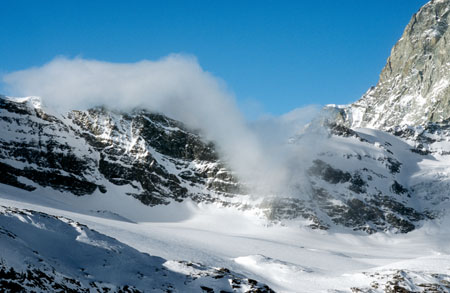, recession As human beings we feel humble and insignificant. This impression is a consequence of our ability to scan the horizon, move our heads and turn to face in any direction. Cameras are less sophisticated and have a field of view that is limited to a small part of the overall scene. They are also unable to record in a single image the climb that we made to reach the viewpoint, or the feeling of the cool fresh air on our faces. When later seen at home, our photographs are therefore often disappointing.
 While most photographers would agree that it is impossible to “take the mountains home”, it is possible to achieve a closer approach to perceived reality. The scale of the scenery will be more apparent if foreground detail is included. People, trees, buildings and cable cars provide a sense of depth and a visual clue to the magnitude of the peaks. A wide-angle lens diminishes the size of the mountains but exaggerates perspective and allows the inclusion of environmental information. A short telephoto lens enhances the impression of size in the mountains, compresses the space between foreground and background, and makes possible the inclusion of more distant foreground detail. Aperture must be set to achieve the necessary depth of field, so a slow shutter speed and a tripod may be necessary.
While most photographers would agree that it is impossible to “take the mountains home”, it is possible to achieve a closer approach to perceived reality. The scale of the scenery will be more apparent if foreground detail is included. People, trees, buildings and cable cars provide a sense of depth and a visual clue to the magnitude of the peaks. A wide-angle lens diminishes the size of the mountains but exaggerates perspective and allows the inclusion of environmental information. A short telephoto lens enhances the impression of size in the mountains, compresses the space between foreground and background, and makes possible the inclusion of more distant foreground detail. Aperture must be set to achieve the necessary depth of field, so a slow shutter speed and a tripod may be necessary.
Another technique for recording scale is to use recession. This is a consequence of atmospheric haze that makes each range of progressively more distant mountains appear less distinct and lighter in tone. The eye interprets the changes of density as distance and hence restores scale to the image. In high mountain ranges it is worth using an ultraviolet or skylight filter to reduce the excessive blueness of distant scenery. The effect becomes less noticeable when the mountains are reasonably close.
Mountains tend to generate their own weather so photographers must be patient and ready to take advantage of good light. The best images are usually obtained a daybreak when the skies are at their clearest and the peaks may be largely visible. Alpenglow, an attractive pink tint of the sky, appears briefly just before dawn. First light progressively bathes mountains in warm light and, if you are lucky, turns them momentarily pink. It is important to be ready with camera and tripod set up. Nature’s light shows are magnificent in every sense but change rapidly and do not last long. The end of the day can also be a rewarding time for photographers with peaks turning red or gold, and the possibility of coloured skies. However, clouds tend gather during the day so views may be less clear and more moody.






